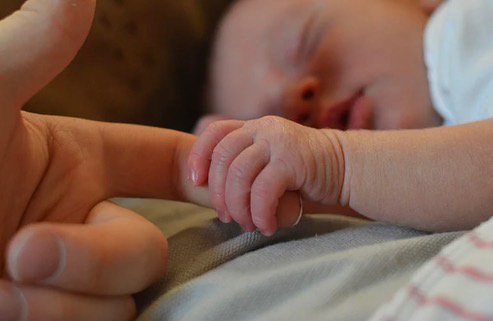Starting Early with Montessori: Activities for Newborn Babies
Co-Written with Melyssa Knowles, a Certified Montessori Guide and Host of, The Montessori Adult Podcast.
Montessori, a philosophy and life-long educational approach developed by Dr. Maria Montessori, is often associated with preschool and early childhood education. However, its principles can be applied from the very beginning of a child's life, including the newborn stage and extend into adulthood. Its benefits extend beyond learning, encompassing holistic development, mental health, and fostering a lifelong love for learning. As parents embark on the Montessori journey with their newborns, the challenge lies in selecting the right activities to prioritise and focus on.
We see four key themes in the Montessori environment for newborns
1. Establishing an Intentional Environment:
Creating a consistent intentional environment is fundamental in Montessori philosophy. For newborns, this involves arranging their surroundings to be orderly and predictable. A clutter-free space with minimal distractions allows babies to focus on essential stimuli where less really is more. It also enables your newborn to begin familiarisation with the environment. Providing soft lighting, gentle (and neutral) colours, and natural textures are better able to engage their senses. Consistency in the environment fosters a sense of security.
A Montessori classroom for infants, sometimes referred to as “The Nido” (Italian for "nest"), accommodates non-mobile or crawling infants in a peaceful classroom environment
according to the American Montessori Association. Here, the infant safely explores, feeling secure in the presence of loving adult caregivers. The environment includes developmentally appropriate furniture and materials. Creating a safe space where infants can freely move, free from sharp edges, and interact with their surroundings promotes motor skills, curiosity, and a sense of agency, often referred to as “freedom with limits”.
2. Honouring the Baby:
In the Montessori philosophy, honouring the individuality of each baby extends to creating an environment that allows for unrestricted movement and exploration, fostering a sense of autonomy from the very beginning. Equipment that restrict the newborn`s freedom of movement, such as bouncers, rockers, should be limited (as much as possible). Baby carriers and slings can also be used if handled carefully. Prioritise the use of baby carriers or slings that allow your newborn to move parts of their body. An unborn baby can move freely in the womb. Therefore, after the baby is born, it is important for adults to respect the newborn`s developmental needs for touch and movement by enabling them to continue to move freely while using these equipment.
It can also be important to keep the room well-ventilated and ensuring a comfortable temperature can help promote an environment where your baby feels more at ease to move freely.
An important but often neglected element to consider that supports a newborn movement is clothing. Even though, an environment may contain all of the above characteristics, improper clothing can be a barrier to your newborn to explore the environment with its body.
“Newborns prefer clothing that allows their hands and feet to be free and allows them to actively respond to their desire to move.”
Dr. Maria Montessori often believed that 'What the hands does the mind remembers', meaning that more physical contact your newborn has with its surroundings, the more the brain will be facilitated to develop. Natural textures - such as cotton (instead of polyester and similar) are suitable not only for newborn materials and clothes, but also for bedding, giving a soft and soothing feel to the newborn baby's body.
Honoring your newborn is also similar to asking and telling your baby before you hold them. The newborn builds trust and becomes aware of its body. When interacting with baby and an object, show the object to the newborn first, slowly approach it to their hands and wait for a grasp. One first material to introduce to your newborn is the Montessori gripping ball in black & white.
3. Communicating Thoughtfully:
Effective communication with a newborn involves both verbal and non-verbal cues. When talking to your newborn, the mother's voice is reassuring for newborns because it was heard in the womb. Montessori encourages the use of simple, clear language and gentle tones. It is helpful to start practicing appropriate vocabulary with your newborn as early as possible. Therefore, trusting a newborn's understanding of language means naming things according to their nature, for example,
"Dog instead of doggy, horse instead of horsey, cat instead of miaow-miaow'
Giving things real names introduces your newborn to more specific language. Narrate daily activities, sudden noises, describe the surroundings, people in your home, and respond attentively to the baby's vocalizations.
“Through thoughtful communication, infants develop language skills, a foundation for later cognitive and social development.”
At first, it can feel awkward to talk to your newborn because he or she seems unresponsive. You can start by telling your newborn their name, what they’re wearing, or singing a song. Newborns communicate a lot with their eyes, as long as you maintain eye contact, communication will take place.
4. Encouraging the absorbent mind
The concept of the "absorbent mind" in Montessori philosophy was sparked by Maria Montessori when she observed how children learned a language without anyone teaching them. This highlights the extraordinary ability of children, even from a newborn age because the absorbent mind happens from birth to the age of six to effortlessly absorb and internalize information from their surroundings.
A baby's mind is like a sponge, soaking in sensory experiences, visual stimuli, and the nuances of their environment. Montessori principles leverage this innate capacity by encouraging intentional and enriching interactions.
Maria Montessori describes a child in this stage of development as a “sensorial explorer”
This describes infants and children navigating the concrete environment and refining the five senses.
Mobiles with contrasting patterns and colours, carefully selected age-appropriate toys, with realistic elements to them, and a safe, free-moving space all contribute to stimulating the absorbent mind. This absorbent mind is not only receptive to external stimuli but also actively engaged in the process of self-construction. As parents and caregivers provide a thoughtfully curated environment, they become facilitators in nurturing a foundation for lifelong learning, curiosity, and holistic development in the absorbent minds of their little ones.
What is a good starting point in Montessori for my newborn?
1. Skin-to-skin contact is a newborn's most important need. Since the newborn is no longer in the womb, the newborn will feel the same sensations through skin-to-skin contact that he or she felt in the womb. Listening to their heartbeat and breathing and being close to you is the best way to promote your newborn's personal, social and emotional development (The Kavanaugh Report).
2. Black and white toys are an excellent introduction to newborn, e.g. black and white cards or black and white image galleries. They respond to the stage of their vision development. You can implement these from the first day to your little one.
3. Grasping a rattle or even with finger is an early start to develop your newborn's muscles.
4. Tummy time is very important for a newborn's physical development. It can be introduced from the first day of a newborn's life. The tummy time process occurs in stages. It's okay if your newborn stays on their stomach for just a few seconds. Consistency is key, and as the days go by, the amount of time your newborn spends on their stomach will naturally increase.
5. Montessori Mobiles are a precious stimuli to offer to your newborn. There are four types of Montessori mobiles:
Munari Mobile
The first one is the Munari mobile, which can be introduced between 3 and 6 weeks of age. The Munari mobile is black and white with a contrasting pattern that promotes vision and concentration in newborns, for example, The Gallery.
Octahedron Mobile
The second Montessori mobile introduced between 6 to 8 weeks is the Octahedron mobile. This mobile is made up of primary colours so newborns can learn about colour and volume.
Gobi Mobile
The third Montessori mobile that will appear from week 8 to week 10 is the Gobi Mobile. The Gobi Mobile consists of five balls of the same size and colour, starting from the darkest colour. Gobi Mobile improves colour vision and colour gradations in newborns.
Dancers Mobile
Last but not least, the Dancers Mobiles to introduce between 10 and 14 weeks. Dancers Mobiles consists of four figurative shapes. Help babies develop deep perception and improve visual control. Important to note is that the mobile is best placed approximately 20-30 centimeters above your baby's belly. Finally,
“The most natural mobile you can offer your baby is to observe trees during daily walks. Natural beauty is irreplaceable.”
Embarking on a Montessori journey with newborns involves weaving these principles into the fabric of daily interactions. Consistency, purposeful engagement, respect for individuality, thoughtful communication, and support for independence lay the foundation for holistic development. As caregivers navigate the vast landscape of Montessori activities, the key lies in observation and responsiveness to the unique needs of each baby. Starting early with Montessori not only nurtures a child's intellectual abilities but also fosters emotional well-being, creating a strong foundation for a lifetime of learning and growth.
Co-written with Melyssa Knowles, a Certified Montessori Guide and Host of, The Montessori Adult Podcast.





